The Cable rear delt fly, also known as the reverse cable fly or high cable rear delt fly, is an exercise that increases deltoid muscle definition and strength.
The rear delt cable fly exercise targets your upper back and shoulder muscles, particularly the posterior deltoids, or rear deltoids. It also improves posture by reducing the effects of rounded shoulders.
A well-developed rear delt is an important feature for lifters and bodybuilders. It is one of my favorite exercises for building a strong upper back.
However, performing this exercise can be tricky, especially if you’re unfamiliar with the correct form. That’s where this ultimate guide comes in.
Let’s explore the following:
- What is the cable rear delt fly?
- What muscles does the rear delt fly train
- How do you perform it correctly?
- Best rear cable fly variations.
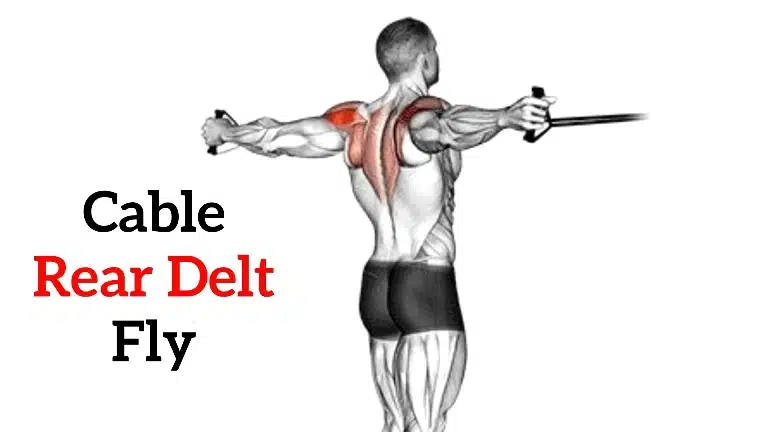
- What Is The Cable Rear Delt Fly?
- Cable Rear Delt Fly Muscles Worked
- How To Do High Cable Rear Delt Fly
- Tips And Form For Rear Delt Cable Fly
- Rear Delt Cable Fly Variations
- 1. Bent Over Rear Delt Cable Fly
- 2. Lying Reverse Fly (Supine Cable Reverse Fly)
- 3. Incline Bench Cable Rear Delt fly
- 4. Single Arm Bent Over Cable Rear Delt Fly
- 5. Single Arm Standing Cable Rear Delt Fly
- FAQ
- Is the cable rear delt fly good?
- How do you hit rear delts with cables?
- What muscle does the rear delt fly work?
- How often should I train rear delts?
- Takeaways
What Is The Cable Rear Delt Fly?
The cable rear deltoid fly is an isolation exercise that targets the posterior muscles. But the word “isolation movement” can be confusing. To avoid confusion, it is more accurately described as a single-joint exercise.
When you do it, it is primarily felt at the rear delt and also trains traps and rhomboids to some extent.
This exercise uses a cable machine with a handle attachment to make a fly-like movement. The handles are pulled away from the body using the muscles in the back of the body.
Imagine spreading your arms wide as if you were giving someone a big hug, but in reverse, as opposed to a cable chest fly, where you pull forward.
There are many ways to perform these exercises, such as grip (pronated and neutral grip) and pulley position. I usually choose a handle that is about shoulder height and grab it with a neutral grip.

Cable Rear Delt Fly Muscles Worked
The rear delt cable flies primarily muscle-worked Rear deltoid.
In addition to its target, the main rear delt muscles. The cable rear delt fly involves several synergist muscles, including Rhomboids, Infraspinatus, Teres Minor, and Teres major.
Some other muscles worked or played stabilizer muscles, including your erector Spinae, Lateral Deltoid, Trapezius, Obliques, and Rectus abdominis.
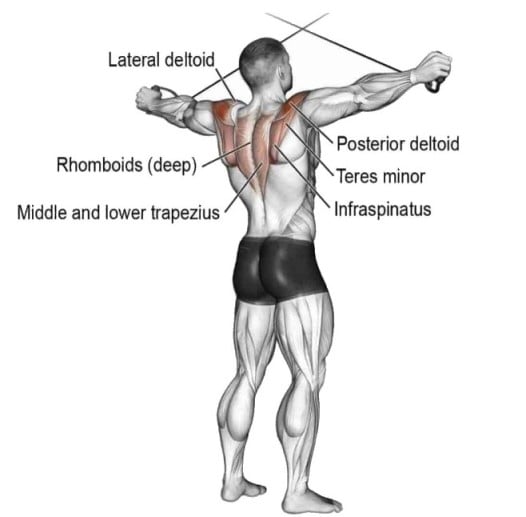
Want to take your gains to the next level? Discover your daily calorie needs with our free TDEE calculator
How To Do High Cable Rear Delt Fly
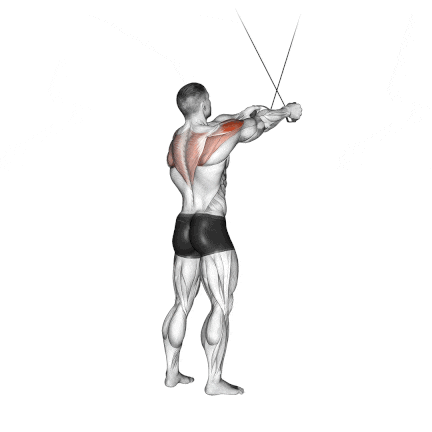
- Attach the handle attachments by adjusting the cable pulleys to the highest position. Make sure that both pulleys are the same height.
- Stand in the center of a cable crossover apparatus. Position your feet shoulder-width apart for stability.
- Start with hands crossed in front of you at shoulder height, with the left high cable in your right hand and the right in your left hand.
- Take a step back to create tension in the cable. Engage your core for stability.
- With your elbows slightly bent, pull your arms out to the sides in a controlled and deliberate manner. Squeeze your shoulder blades together as you do the move.
- Continue pulling your arms pull out and back as far as possible. Pause for a moment at the peak contraction, feeling the engagement in your rear deltoids.
- Slowly lower your arms back to the starting position.
- Do 8–12 reps and 3–4 sets.
Tips And Form For Rear Delt Cable Fly
- The posterior deltoid is best targeted with your torso upright, not leaning too far forward or back.
- Keep a controlled motion and avoid jerky movements.
- Throughout the exercise, keep your elbows slightly bent. Avoid fully extending or locking out your elbows.
- Focus on squeezing your shoulder blades together at the peak of the movement to activate your rear deltoid muscles.
- Perform the exercise slowly and calmly, emphasizing the eccentric (lowering) phase.
- Exhale as you pull your arms back, and inhale as you come back. During the exercise, keep your breathing steady.
- Your oblique muscles must be engaged to sustain a stable torso throughout the movement.
- You should aim to complete 3-4 sets of 10-12 reps of the cable rear delt fly.
- As you become more comfortable with the form, change your set and rep ranges to challenge yourself.
- It can be used as a finisher in a shoulder or back workout.
- Use lightweight, as it lets you focus on proper form and technique, achieving better results.
- To target the posterior deltoid, your arms should move directly back (and downward slightly), almost parallel to the floor.
- If the hands are raised through a higher arc to a point above shoulder level, the trapezius, and lateral deltoid make a bigger contribution to the movement.
Rear Delt Cable Fly Variations
Above, we dissected the traditional variation of the cable rear delt fly. This fly version is usually seen and is an excellent back and shoulder exercise in its own right.
Furthermore, there are several variations that you can do to achieve different muscle activation. While the primary function of the exercise is there, these fly variations can feel like a new movement.
1. Bent Over Rear Delt Cable Fly
If you’re looking for straightforward cable machine rear delt exercises to add to your workout routine, the bent-over cable fly is a great staple exercise to get you started.
It is a variation of the cable fly exercise that primarily targets the rear deltoids, upper back, and rhomboid muscles.
Unlike dumbbell raises, where the resistance varies during the lift, the cable pulley affords a uniform resistance throughout the motion.

How To Do Bent Over Rear Delt Cable Fly
- Attach D-handles to the low pulleys and select an appropriate weight.
- Grab the handles attached to two low pulleys (left-side handle in right hand, right-side handle in left hand)
- Stand in the middle, then bend forward at the waist with the back straight and parallel to the floor.
- Raise your hands upward in an arc to shoulder level so the cables cross over.
- Lower the handles back down to the start position.
Tips For Proper Form
- Pull slowly so that you have total control of the weight.
- Remember to breathe out when you work hard.
2. Lying Reverse Fly (Supine Cable Reverse Fly)
When you do this exercise and pull the cables down to the sides, you will focus purely on contracting your rear delts.
It’s important to keep your arms perpendicular to your trunk to reduce the involvement of your lats in completing the exercise.

How To Do Lying Reverse Fly
- Position a flat bench between two high pulleys.
- The handle of the right pulley should be in your left hand, and the handle of the left pulley should be in your right hand.
- The cables should be pulled tightly and crossed.
- Keep your arms perpendicular to your torso and your elbows slightly bent. Exhale as you pull your arms open and out to the sides.
- Hold for a count of two. Inhale as you slowly return to the starting position. Repeat for desired reps.
Tips For Proper Form
- When lying down, ensure your shoulders are lined up with the pulleys. This will ensure optimal mechanical leverage.
- Keep the movement slow and deliberate.
3. Incline Bench Cable Rear Delt fly
Finally, if you’re looking for one more effective cable rear delt exercise variation, try the Incline bench cable rear delt fly. It targets the rear deltoids and the postural muscles of the upper back.
This exercise targets such small muscles, so it is usually performed with lightweight weights for high reps, such as 10-15 reps per set or more.
The incline bench removes the potential of using momentum and makes the movement more challenging.

How To Do Incline Bench Cable Rear Delt fly
- Place an incline bench sideways midway between two cable stations.
- Grasp the D-handles attached to the cables with the opposite-side hand.
- Lean your chest against the incline bench (45 degrees).
- Keep your feet on the floor for stability, with your chest up and abs tight.
- Keeping your arms slightly bent, raise the cables out to your sides as high as possible.
- Slowly lower the cables back to the start, but don’t let the weight stack touch down at the bottom before beginning your net rep.
Tips For Proper Form
- Do not lift backward or forward.
- Set a bench at about 30-45 degrees inclined.
- Keep form strict to isolate the rear delts.
4. Single Arm Bent Over Cable Rear Delt Fly
You can do this exercise using one arm at a time, allowing you to alter the range of motion by adjusting the start or finish position.
This is a great exercise for working on each side of the shoulder. This helps your muscles be more balanced and symmetrical.
This unilateral version allows you to raise your hand higher and get a longer stretch at the bottom, thereby generating more work for the posterior deltoid. It is usually performed for moderate to high reps, as part of an upper-body or shoulder-focused workout.
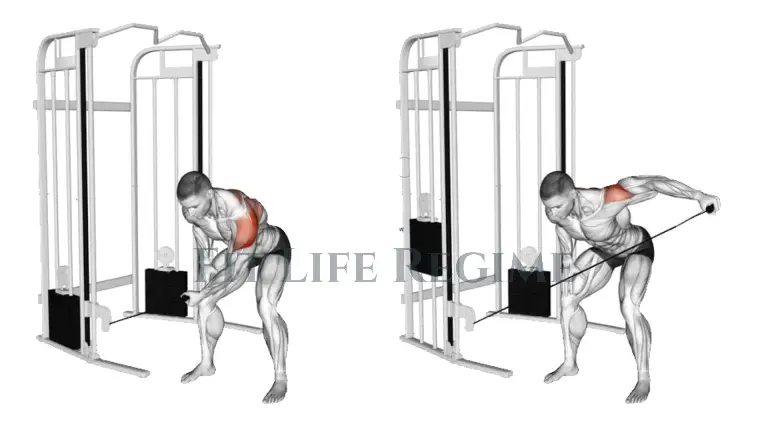
How To Do Single Arm Bent Over Rear Delt Cable Fly
- Attach a D-handle or a single-hand attachment to a low cable pulley.
- Adjust the height of the pulley to a position that is comfortable for your arm’s range of motion.
- Lean forward at the hips, and place your right hand on your thigh.
- Hold a handle in your left hand with your arm extended straight down.
- Raise the weight straight out to the side until your arm is parallel with the floor.
- Then slowly lower the weight back up to the starting position.
- Repeat with the right arm.
Tips For Proper Form
- Pull slowly so that you are always in control of the weight.
- Remember to exhale while you exert.
- Your torso should be at a roughly 45-degree angle.
- Keep your neck and spine in line, and don’t stretch or bend your back too much.
5. Single Arm Standing Cable Rear Delt Fly
When the cable rear delt flies with a single arm, it allows for a greater range of control. This exercise will also strengthen your mind-muscle connection.
Doing the exercise with one arm at a time helps you find and fix any differences in strength or muscle size between your left and right sides. This helps your muscles to be more balanced and symmetrical.
It also builds muscle and strength in the triceps, and is a good upper body exercise.
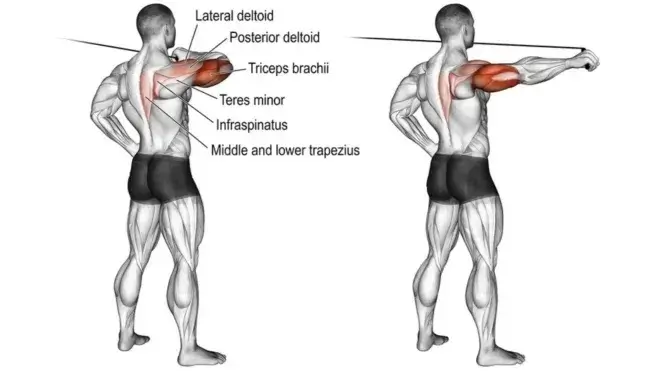
How To Do Single Arm Standing Rear Delt Cable Fly
- Attach a rope to a shoulder-height cable pulley.
- Then, stand so the left side of your body faces the cable pulley and grab the rope with your right hand.
- Now, take one step to the right, so there’s tension in the cable.
- Then, pull your elbow back and away from the pulley so it’s facing in the opposite direction.
- Exhale and extend your arm to the right, so your arm is straight.
- Inhale and slowly bring your arm back to the starting position.
Tips For Proper Form
- It’s best to use light to moderate weights for this exercise to minimize joint stress and maintain good form.
- Keep your back straight and core engaged.
- Keep your upper arm horizontal. If your elbow drops, your latissimus dorsi will get involved.
FAQ
Is the cable rear delt fly good?
The cable rear delt fly is perhaps the best isolation exercise for your posterior deltoid and back. You need to be doing them.
How do you hit rear delts with cables?
To hit the rear delt with a cable, start with your hands crossed in front of you at shoulder height, with the left high cable in your right hand and the right in your left hand.
Use your rear delts to pull your elbows out and back as far as possible, then slowly return to the starting position.
What muscle does the rear delt fly work?
The rear delt fly works your upper back muscles and shoulder muscles, particularly the rear deltoids, on the backside of your shoulders.
How often should I train rear delts?
To gain muscle, train your muscle no more than two times per week, or give it a minimum of 48 hours rest before training it again. Train your rear delts with 10-to-20 sets per week.
To develop any major muscle group, including your rear delts, it’s generally best to train it with 10-to-20 weekly sets.
Takeaways
Now that you know a few variations for your cable rear delts fly, hit the gym and try each one to get the full effect. Don’t limit yourself to variations on this exercise, either. There are several alternatives you can use to keep your workouts productive and interesting:
The cable rear delt fly is the perfect exercise, as it uses a light load and requires a tremendous mind-muscle connection.
Seek new and interesting ways to perform all your staple movements so that you never get stuck waiting at the gym, never grow bored, and always keep growing.

Manish is a NASM-certified fitness and nutrition coach with over 10 years of experience in weight lifting and fat loss fitness coaching. He specializes in gym-based training and has a lot of knowledge about exercise, lifting technique, biomechanics, and more.
Through “Fit Life Regime,” he generously shares the insights he’s gained over a decade in the field. His goal is to equip others with the knowledge to start their own fitness journey.

